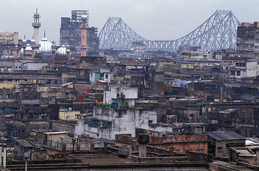
Undertaken with the support of the United Nations Development Programme (UNDP), India: Urban Poverty Report 2009 identifies the problems faced by the poor and focuses on the systemic changes that are needed to address them.
“The pace of urbanisation in India is set to increase, and with it, urban poverty and urban slums, despite 62 percent of GDP now being generated in towns and cities,” Minister for Housing and Urban Poverty Alleviation Kumari Selja said at the February 3 launch in Delhi.
The report examines various issues related to urban poverty, such as migration, labour, the role of gender, access to basic services and the appalling condition of India’s slums. It also looks at the dynamics of urban land and capital market, urban governance, and the marginalisation of the poor to the urban periphery.
Key messages of the report include:
-
Poverty in India has become urbanised. Urban poverty in India is over 25 percent; some 81 million people live in urban areas on incomes that are below the poverty line. At the national level, rural poverty remains higher than urban poverty, but the gap is closing. By 2030, urbanisation in India is projected to reach 50 percent.
-
Migration towards urban centres has increased, indicating that economic reforms have not been effective in creating jobs in small and medium towns as well as rural areas. Poverty was higher among rural to urban migrants, while the most successful migrants are those who move from one urban area to another.
-
Urban poverty poses different problems. The nature of urban poverty poses distinct challenges for housing, water, sanitation, health, education, social security, livelihoods and the special needs of vulnerable groups such as women, children and the aging.
-
Slum populations are increasing. According to a 2001 census, India’s cities have a slum population of 42.6 million (23.7 percent of the urban population). The majority (11.2 million) are in Maharashtra, whose capital city Mumbai is home to the Dharavi slum. While the slum population has increased, the number of slums has decreased – resulting in greater density.
-
Slum dwellers lack access to basic services. Most slum dwellers do not have access to clean water, sanitation and health care facilities. They face a constant threat of eviction, removal, confiscation of goods and have virtually no social security cover. Some 54 percent of urban slums do not have toilets; public facilities are unusable due to a lack of maintenance.
Proposed solutions to urban poverty include a greater equity in the provision of basic services, targeted subsidies for vulnerable sections of the population, and special government assistance to strengthen the economic bases of small and medium towns.
In slums, the report recommends organising slum communities, extending sewage systems and electricity to slum areas, and constructing public toilets that will be maintained by the community.
India: Urban Poverty Report 2009 is part of a UNDP-supported government project to develop a national strategy for urban poverty.
Ministries seek additional funding for infrastructure, social sector
In related news, the India Express reported February 9 that the Ministry for Housing and Urban Poverty Alleviation and the Ministry of Urban Development have requested more than double the funding under the Jawaharlal Nehru National Urban Renewal Mission (JnNURM) for the next fiscal year.
JnNURM, the Indian government’s massive fast-track city modernisation initiative, currently covers 63 cities throughout India.
For more information about India: Urban Poverty Report 2009, please visit the UNDP India website.
For more about JnNURM, please visit its English-language website.




